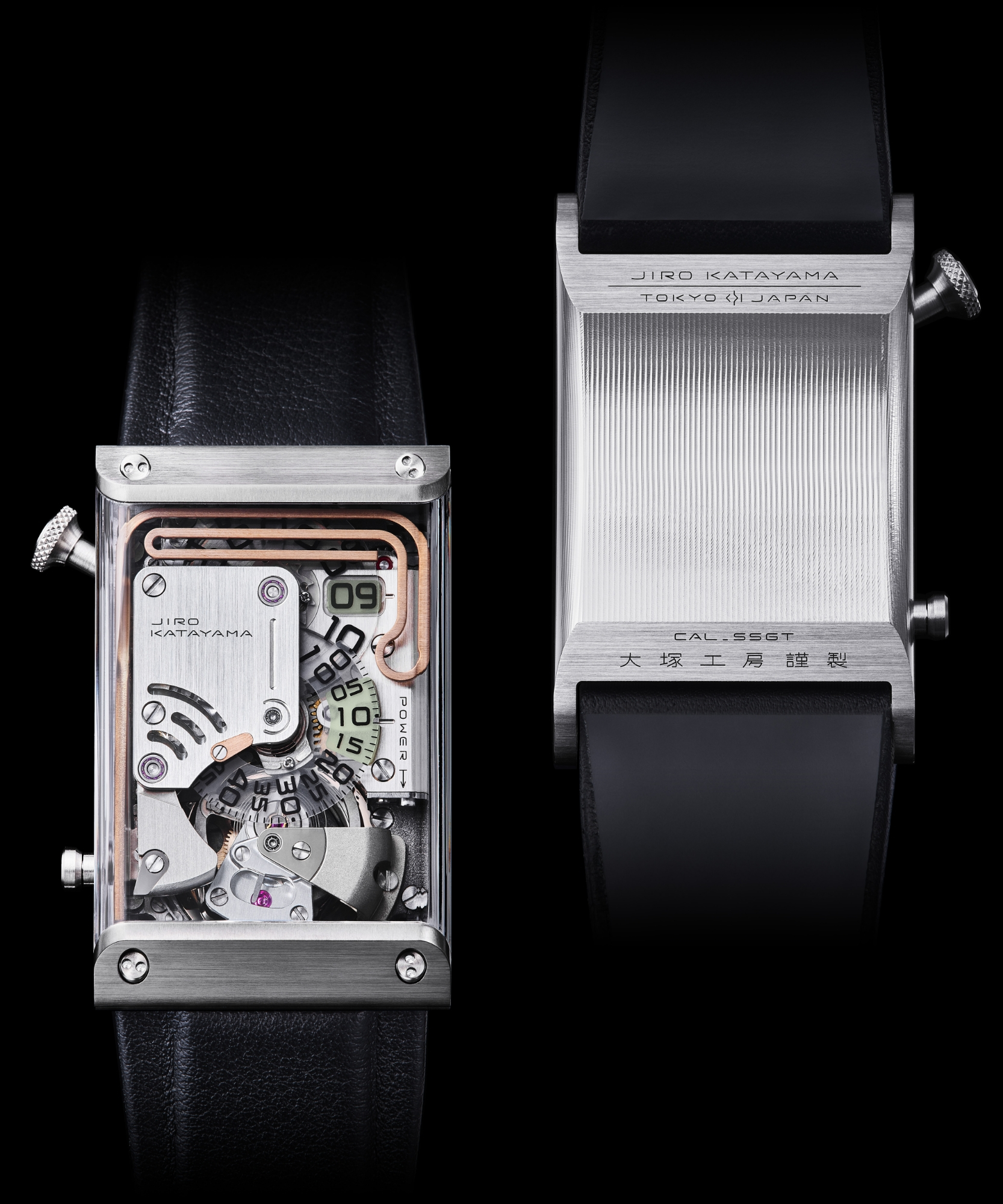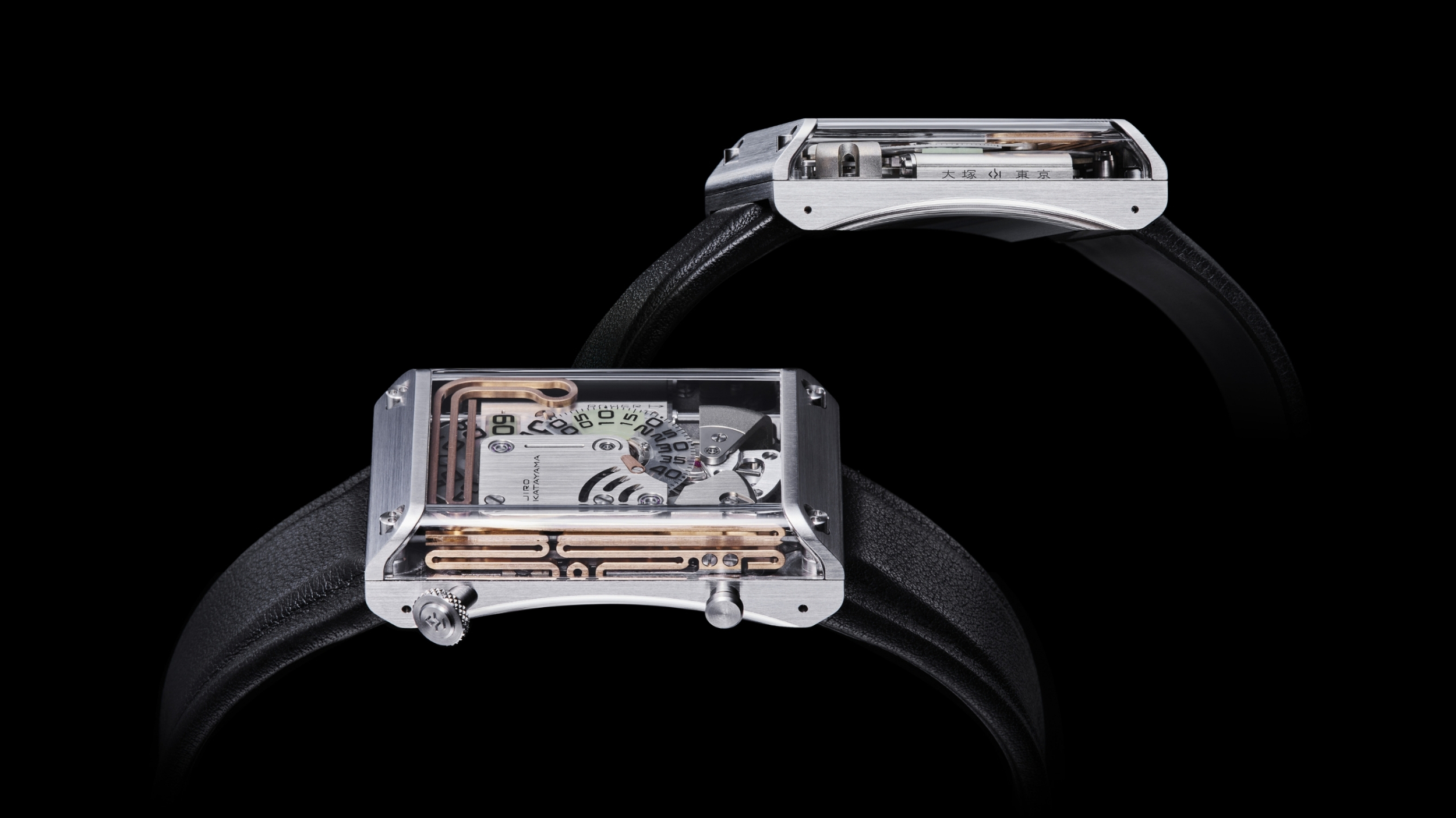Known for his industrial watch aesthetic, Japanese designer/watchmaker Jiro Katayama has created an intriguing tourbillon-equipped timepiece, inspired by vintage Japanese electric meters.
The Otsuka Lotec No. 9 features a 30 mm x 13 mm rectangular-shaped case, with a lug-to-lug measurement of 44 mm, and a footprint similar to that of a Reverso or Tank.
Visually, the design and finishing do not represent Haute horology. The horological complications and the price tag, however, do veer into the realm of luxury watchmaking. Technically, the watch offers an impressive mix of complications, including jumping hours, rewinding minutes, a tourbillon, hour-striking, and a power reserve indicator.
Hours are indicated digitally, via a translucent mechanical jumping hours disk mounted in the upper right quadrant of the dial. Overlapping the hours is another translucent disc, mounted in the center of the dial, indicating minutes. Interestingly, the minutes “rewind” in a similar way to a retrograde minutes mechanism, and it can best be described as the way an analog body weight scale goes back to zero, according to the brand. A hairspring at the center of the disk serves as the driving force, snapping the minute disk back to zero at the change of each hour.
Cleverly, as a way of reading the time in low light, a luminous block has been embedded beneath the disks, illuminating the numerals from below.
Another complication of this unique piece of horology is an hour-striking function that activates a hammer that strikes a pipeline-shaped gong on the left side of the dial, producing what the brand refers to as “a crisp, industrial chime.” This can be heard on the short brand-produced video embedded below.
The power reserve is displayed by a slim indicator on the right side of the dial, represented by a rod that moves in or out (just below the POWER label arrow), and has a 40-hour maximum reserve.
Driving the functions is a manually wound caliber SSGT, which is reportedly made in-house, and that measures 26.4 mm x 41.3 mm with a thickness of 10.35 mm. The 3Hz movement has 39 jewels, a free-sprung balance wheel that’s housed inside a rotating tourbillon cage, and consists of 287 total components.
For the central shaft of the hour disk and the hammer pivot of the hour-striking, custom ruby ball bearings made by MinebeaMitsumi, specifically designed for this timepiece, are used. According to the brand, the movement uses 2.5 mm ruby ball bearings custom-made by MinebeaMitsumi and 1.5 mm ball bearings (the world’s smallest), also made by MinebeaMitsumi.
The sapphire glass and top of the case, which is secured to the caseback by 4 distinctive double circular slotted screws, is exposed on the side, allowing for better additional views of the mechanical components and the power reserve indicator. A large, knurled industrial crown on the top left is used to wind and set the watch, and a push button on the lower left flank allows you to turn the automatic hourly chime on or off.
The caseback is machined from a solid block of 316L stainless steel and shaped with a gentle curve to fit comfortably on the wrist. The watch is water-resistant to 30 meters. A black calfskin strap, that tapers at the buckle, attaches to the 26 mm wide lugs.
“I came up with the idea of designing this wristwatch that, much like an induction electric meter, would let you see different mechanical parts arranged inside a transparent case and watch them in motion. So, I set out to design the movement completely from scratch. The way the exposed parts present themselves might remind you of things like vacuum tubes, a camera viewfinder, or even the cityscape of an industrial area. With № 9, I wanted to create a watch where every moving part under the sapphire crystal gives off the feeling of industrial machinery — its textures, vibrations, and sounds.”
The retail price is approximately $108,000. It’s unclear if that includes US import tariffs.
Learn more at Otsuka Lotec.
Photos by Otsuka Lotec.


